Many native plants in Florida, like the American beautyberry, are non-threatening species with beautiful style. And other plants, like the Brazilian peppertree, are highly invasive and cost Florida millions of dollars to manage. So let’s explore the top 12 most invasive plants in Florida that choke out native habitats at surprising levels of speed and destruction. Whether grasses, shrubs, or vines, these 12 plants have a vice grip on Florida landscapes and government funding.
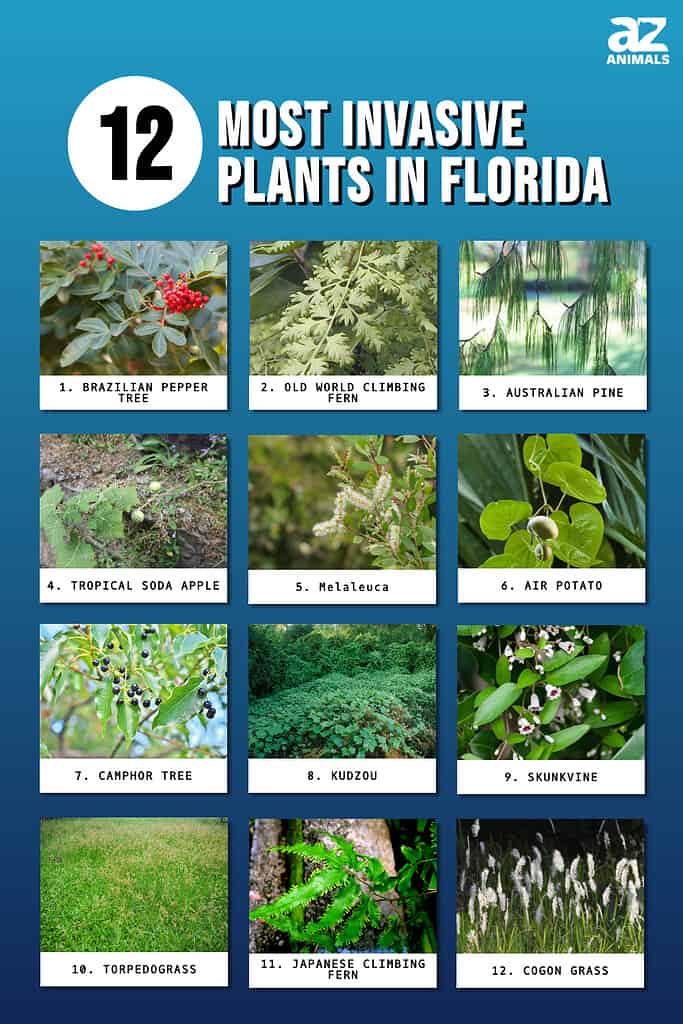
The Cost of Florida Invasive Plants
The Florida Department of Agriculture and Consumer Services (FDACS) estimates invasive plants cost Florida taxpayers over $30 million yearly in management efforts and education.
Additionally, the high cost of invasive plants to Florida farm and timber industries is staggering. For example, highly invasive plants like kudzu (a vine) can infest a farmer’s fields and result in massive crop loss. Not only does kudzu become mixed with crops, but it brings more plant pests and diseases with it too. The FDACS estimates that kudzu infestations alone cost Florida over $500 million in lost farm and timber industry revenue. Plus, infested crops become unusable as food for a farmer’s own livestock.
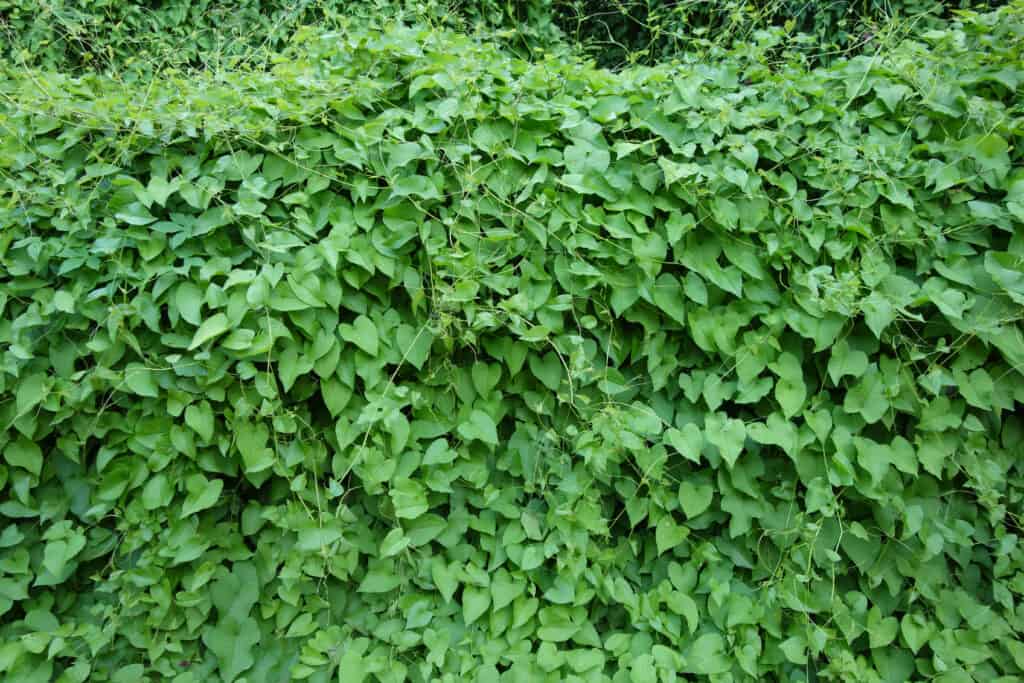
Invasive kudzu vines cost Florida over $500 million per year in lost farm and timber industry revenue.
©SATYAJIT MISRA/Shutterstock.com
So what can Florida citizens do to help? A significant first step is to learn more about Florida’s invasive plants, like the ones in our list below.
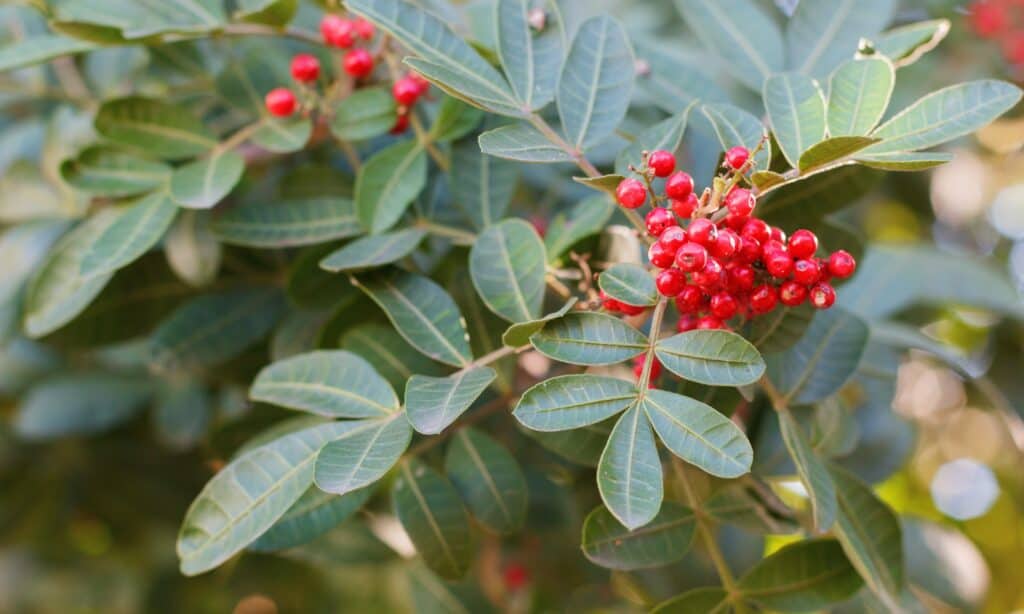
The Brazilian peppertree is a highly invasive shrub that grows in Florida.
©iStock.com/jantroyka
1. Brazilian Peppertree (Schinus terebinthifolius)
- Plant Description: A Brazilian peppertree is a large sprawling shrub or small tree with branches that seem to grow in all directions. It produces yellow-veined oval leaves, white flowers, and huge clusters of red berries. In fact, each berry cluster can make hundreds of fruit. But don’t eat these berries or any other part of Brazilian peppertrees because they are poisonous.
- Mature Height: 22-32 feet high
- Habitat: Open areas with damp soil, like forest clearings, fields, and coastal wetlands
The Brazilian peppertree is a highly invasive plant in Florida that has infested over 700,000 acres of land across the state. And because of the thick canopy of foliage that this shrub spreads above other plants, it tends to shade out the vegetation around it.
The University of Florida Center for Aquatic and Invasive Plants warns that the Brazilian peppertree is related to poison oak, poison ivy, and poison sumac. Like those toxic plants, the Brazilian peppertree is poisonous to touch or eat, including its berries. However, much of this plant’s toxin comes from sap, which could cause skin and eye irritations.
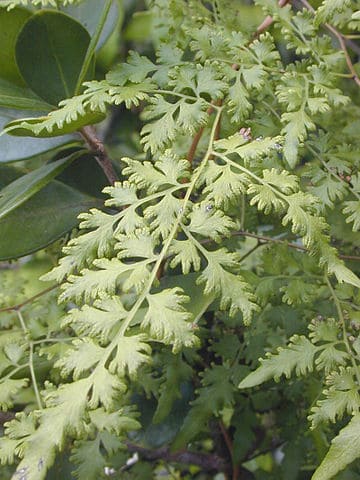
One of Florida’s most invasive plants is the Old World climbing fern.
©Marshman at English Wikipedia / Eric Guinther / Creative Commons – License
2. Old World Climbing Fern (Lygodium microphyllum)
- Plant Description: The Old World climbing fern is a light green and wiry twining vine that produces small wavy leaflets with serrated edges. This invasive Florida plant also creates thousands of spores (reproductive cells) that the wind can carry for many miles. Many new invasive plant colonies begin with the spread of these spores.
- Mature Height: According to the Florida Fish and Wildlife Conservation Commission, Old World climbing ferns can creep via their twining fronds up to 90 feet high with indeterminate growth. A plant with indeterminate growth has a main stem that continues to elongate no matter its reproductive cycle or structure.
- Habitat: Remote areas with moist soil like bald cypress stands, wet forests, and prairies, saw grass marshes, and Everglades tree islands
An estimated 300,000 acres of Florida’s natural habitat are overtaken by the Old World climbing fern or OWCF. This twining fern acts like a creeping blanket of leaves, engulfing everything in its path. For example, OWCF can completely cover bushes, trees, lamp posts, and buildings and keep going.
Old World climbing fern is so invasive it can destroy farmland and forests, make wildlife homeless, and ruin infrastructure. Additionally, this plant’s thick and continuous canopy becomes a fire ladder during wildfires. A fire ladder is a type of vegetation that allows a fire to spread further and more quickly from the ground into trees.
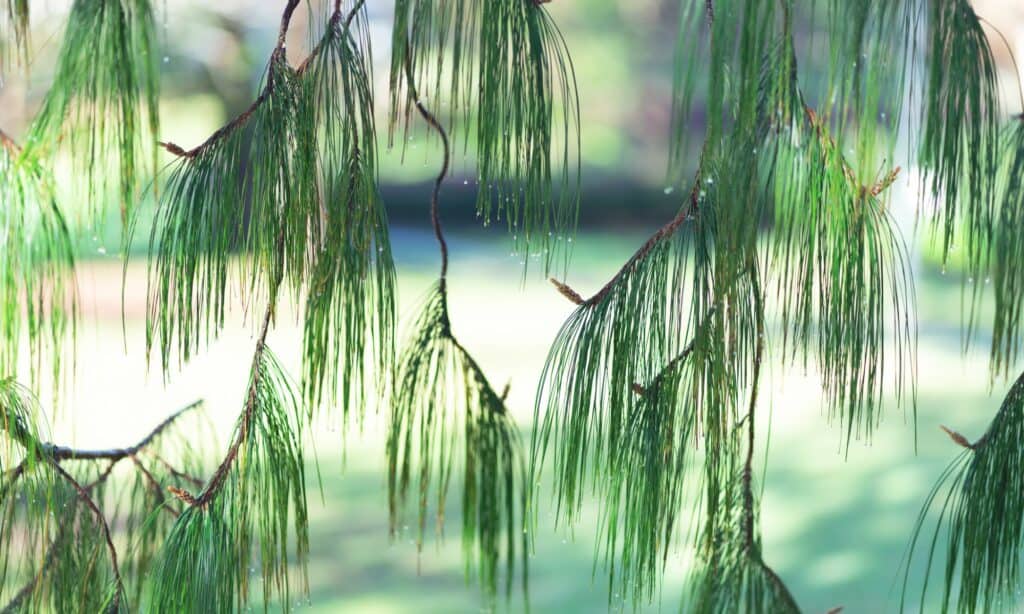
The Australian pine is an invasive plant along Florida coastlines.
©iStock.com/Julia Gomina
3. Australian Pine (Casuarina equisetifolia)
- Plant Description: The Australian pine is a flowering tropical evergreen tree that resembles a palm tree with needle-like branchlets. This invasive plant has reddish-brown bark and creates little brown flowers year-round. It also produces much seed-bearing fruit (called nutlets) inside cone-shaped clusters. The winged nutlets easily fall off the tree and spread through coastal winds.
- Mature Height: Australian pines grow up to 150 feet tall.
- Habitat: Coastal areas with sandy soil and sea salt spray
The Australian pine is an invasive tropical evergreen tree that spreads across Florida’s coastal areas. Also called she-oak, beefwood, and horsetail tree, the Australian pine is native to Australia. Floridians imported and planted this tree as a windbreak near canals and coastlines in the late 1800s. Eventually, this non-native species became more problematic than beneficial.
Australian pines are fast-growing and thrive in the salty air. So they grow best near ocean water and quickly overcome beaches while pushing out native plant species.
These invasive plants in Florida also grow shallow roots in sandy soil, which means Australian pines topple easily during coastal storms. The fallen trees destroy animal homes, like sea turtle nests, and cost more money in beach clean-up efforts.
Australian pine is so invasive in Florida that possessing this plant to grow or sell is illegal unless you have a special permit.

Before it’s ripe, the fruit of invasive tropical soda apple shrubs looks like tiny watermelons.
©Vipul1989/Shutterstock.com
4. Tropical Soda Apple (Solanum viarum Dunal)
- Plant Description: The tropical soda apple is an upright leafy shrub that produces white flowers and small round fruit. The fruit first resembles tiny green watermelons and then matures to yellow. The plant leaves are deeply lobed with pointed tips, and the downy stems have thorns.
- Mature Height: 3-6 feet tall
- Habitat: Semi-shaded fields like croplands and sugar cane fields, pastures, citrus groves, and along roadsides and ditches
The tropical soda apple is an invasive perennial shrub that can take over native habitats within a year or two. This herbaceous plant is one of the most invasive plants in Florida and a noxious weed.
The US Department of Interior Bureau of Land Management defines noxious weeds as any plant designated by the government as harmful to agriculture, property, public health, or wildlife. Unfortunately, the tropical soda apple plant fits this description because it pushes out natural species and serves as a host for many crop pests and diseases. For example, this invasive plant carries diseases that kill vegetables like eggplant, peppers, and tomatoes.
The fact that tropical soda apple grows in livestock pastures can be a huge problem because cattle eat this plant’s fruit and spread its seeds through their stool. This method of invasive plant spread by livestock is such a concern that some states require a quarantine period for cattle before traveling from areas of infestation.
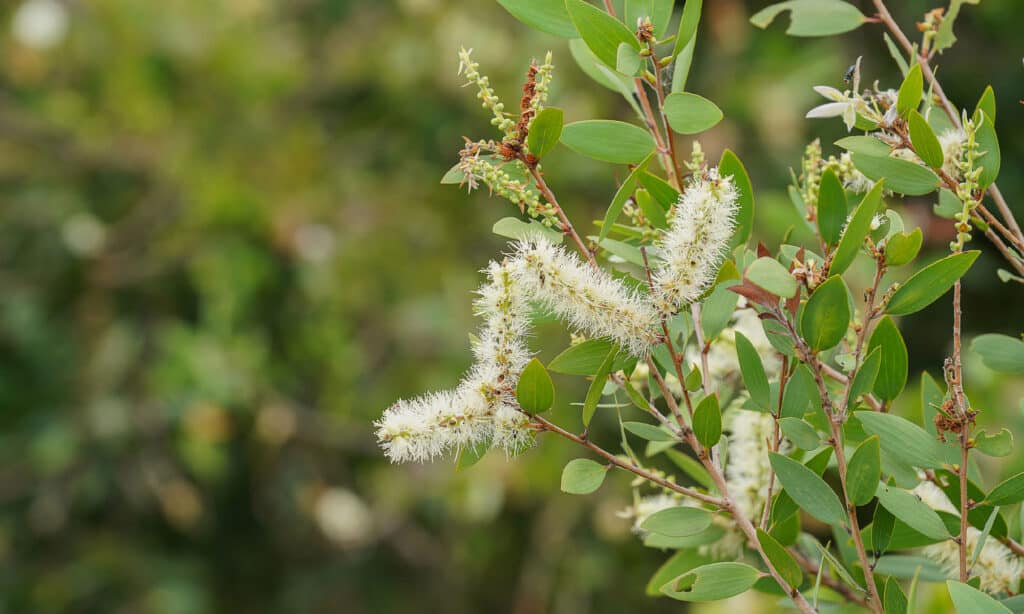
The melaleuca tree is a highly invasive and highly flammable Florida plant.
©iStock.com/Noppharat05081977
5. Melaleuca (Melaleuca quinquenervia)
- Plant Description: The melaleuca is an evergreen tree with long, narrow oval leaves. Its papery greyish-white bark often looks like its many thin layers are about to peel off. Melaleuca also produces small pinkish-white bottlebrush flowers and round woody capsules (its fruit) filled with 200-300 seeds each. This Florida invasive plant also releases the scent of camphor oil when its leaves are crushed.
- Mature Height: 60-100 feet tall
- Habitat: Scrub, lakes, wetlands, marshes, and other areas with wet soil
The melaleuca tree is native to Australia and is a highly invasive plant in Florida’s wetlands. It was first imported and planted in Florida during the late 1800s as a windbreaking shade tree. Later, in the 1930s, melaleuca seeds were spread over the Everglades by airplane, eventually leading to today’s significant melaleuca infestations.
Melaleuca trees grow and multiply quickly into dense stands. They also monopolize water and nutrient resources, destroying native plant populations and displacing wildlife. In addition, melaleuca trees are highly flammable, resulting in quicker wildfire spread throughout infested regions.
Unfortunately, melaleuca trees also produce an enormous amount of seeds that keep this invasive Florida plant spreading far and wide.

The air potato vine is an invasive plant that grows many potato-like bulbils that become new plants.
©Jillian Cain Photography/Shutterstock.com
6. Air Potato (Dioscorea bulbifera)
- Plant Description: The air potato is a vining plant with heart-shaped green leaves. It drops bulbils resembling tiny potatoes that develop into tubers and then new plants. Sometimes these vines will produce little clusters of white and fragrant flowers.
- Mature Height: The air potato vining plant can climb at least 100 feet high up into trees.
- Habitat: Sunny areas near trees with wet soil, including marshes, scrub and floodplain forests, waterways, and sinkholes
The air potato plant officially became a noxious weed in Florida in 1999, and it’s still one of the most invasive plants in the state. This sneaky vine grows quickly, can thrive in poor soil, and creates a thick blanket of leaves over other vegetation by climbing into tree canopies. This growth habit results in the native plants growing below air potato vines perishing from lack of sunlight.
One air potato vine can also produce a lot of new plants via its many bulbils, small secondary bulbs from which new plants can sprout. Air potato bulbils look like tiny potatoes.
Native to Asia, the air potato plants arrived in Florida in the early 1900s and have exploded across the state ever since. This fact is no exaggeration, as this plant’s rapid growth is astounding. For example, a typical air potato plant can grow up to 5 inches in one day and up to 70 feet in one growing season.
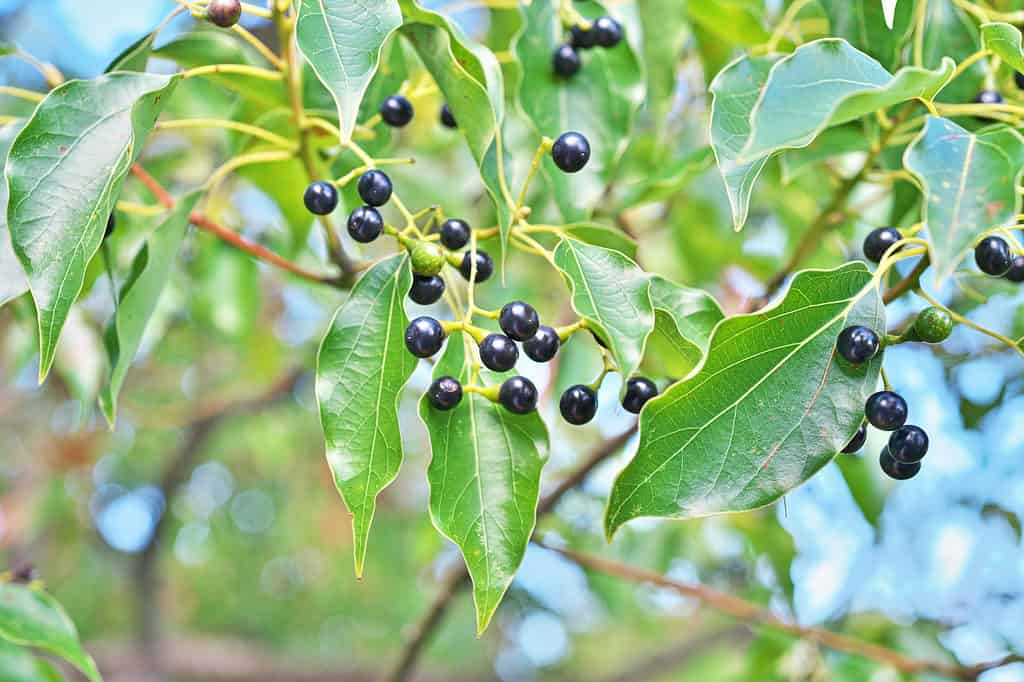
The invasive camphor tree can produce up to 100,000 seeds.
©iStock.com/igaguri_1
7. Camphor Tree (Cinnamomum camphora)
- Plant Description: The camphor is a tall evergreen tree with ovate dark green leaves that are glossy on top. This Florida invasive plant produces fragrant oil you can smell when you crush the leaves. Camphor trees also have aromatic yellow-white flowers and dark blue berries full of seeds.
- Mature Height: 60-70 feet tall
- Habitat: Disturbed areas, roadsides, hardwood hammocks, scrubby flatwoods, floodplains, and areas with wet soil near lakes and streams
First brought to Florida in 1875 as an ornamental, the camphor tree is now an invasive plant. Camphor trees invade and take over natural habitats, endangering native plant and animal species.
One camphor tree can produce as many as 100,000 seeds. So it’s a tough invasive plant to control with all those seeds germinating every growing season.
Though this tree’s berries are a favorite snack for birds like robins, those same birds are responsible for helping spread thousands of camphor seeds throughout the state.
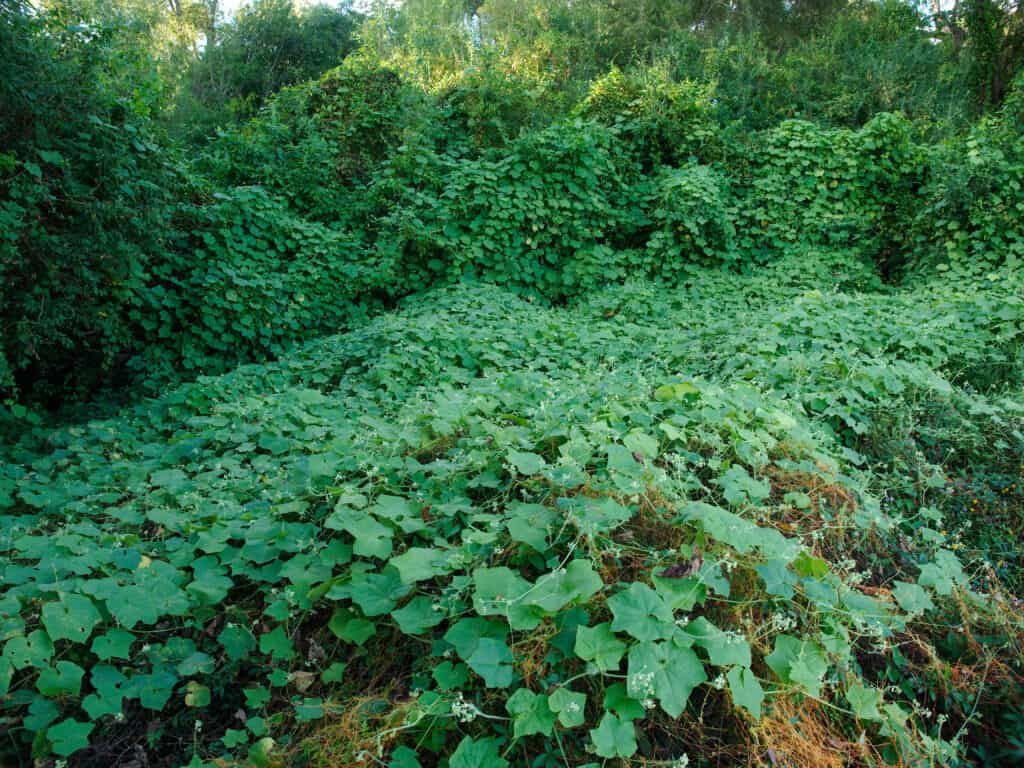
The invasive vine called kudzu climbs into Florida tree canopies and blocks sunlight from the plants below.
©Roberto Michel/Shutterstock.com
8. Kudzu (Pueraria montana)
- Plant Description: Kudzu is a semi-woody perennial vine with green heart-shaped or oval leaves growing in three leaflets. The mature plants produce small purple or red flowers that are very fragrant. Other vines resembling kudzu include grape, bittersweet, and porcelain berry plants.
- Mature Height: Kudzu vines can climb at least 100 feet high
- Habitat: Roadsides, disturbed areas, abandoned fields, forest edges
The Nature Conservancy calls kudzu “the invasive vine that ate the south” because of how it has taken over in Florida and other southern states. Kudzu smothers everything it climbs, including trees and the plants below. It blocks other plants from getting sunlight and clings tightly to its captive host via many vigorous rhizomes, runners, and vines.
Imagine a landscape blanketed in lava from a volcanic eruption. But, instead of burning lava, it’s a blanket of vine leaves as far as the eye can see. Unfortunately, this vision is how some kudzu infestations look across Florida. It’s admittedly an impressive display of natural beauty on the surface. Still, it hides all the vegetation strangulation going on below. And it doesn’t show all the displaced Florida animals that have to find new sources of food and shelter.
Kudzu vines can grow up to 12 inches a day, which is why it’s also called the “mile-a-minute” vine.
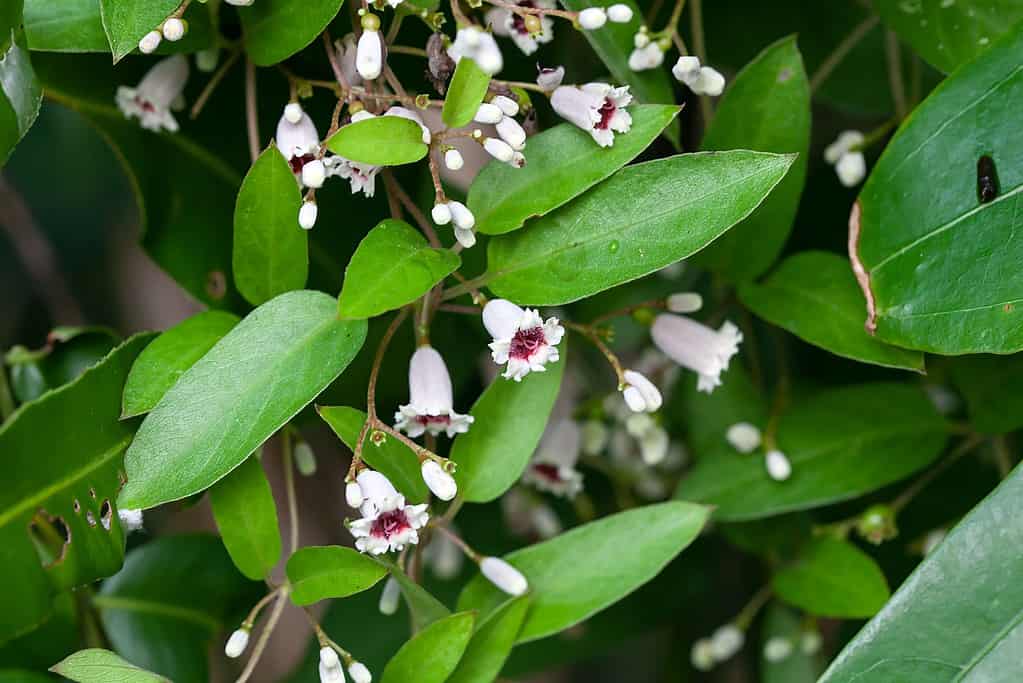
The skunkvine is an invasive plant that releases a skunk-like odor when its leaves are crushed.
©ChWeiss/Shutterstock.com
9. Skunkvine (Paederia foetida)
- Plant Description: Skunkvine is a twining vine with a woody rootstock and lance-shaped or oval leaves. The leaves release a skunk-like odor when crushed. Skunkvine produces white flowers with a lilac throat plus round brown fruit with two seeds inside each.
- Mature Height: According to the Invasive Plant Atlas, skunkvine can grow up to 30 feet long or high
- Habitat: Forests, sandhills, marshes, and floodplains
Skunkvine is a smelly tropical plant native to Asia. It became an invasive plant in Florida after its introduction as an ornamental in the late 1800s. In fact, it’s now illegal in Florida to grow, sell, or transport this noxious weed.
How is skunkvine invasive? Like other invasive vines, skunkvine chokes out the vegetation it climbs and covers. It buries and weakens trees that eventually die and fall to the ground.
Also, like other invasive vines, skunkvine is hard to control because it produces many seeds and powerful roots.
Unique to other plants, the skunkweed releases a very unpleasant odor when you press or crush the leaves. The Florida Museum describes this plant’s smell as similar to “sulfur or rotting cabbage.”

Invasive torpedograss destroys native Florida marshlands.
©Nutdhanai Srito/Shutterstock.com
10. Torpedograss (Panicum repens)
- Plant Description: Torpedograss is a wild green grass with stiff, narrow leaves and hard rhizomes that are torpedo-like under the soil surface. The leaves are downy at the top, and rhizomes create a vast root system that rapidly grows. In its reproductive stage, the torpedograss produces panicle-like (branching) inflorescence (flower heads) that grow 3-9 inches tall.
- Mature Height: Up to 40 inches tall
- Habitat: Pastures, roadsides, ditches, lakeside, lawns, and garden beds
You wouldn’t think a simple grass would become one of the most invasive plants in Florida, but torpedograss proves that theory wrong. Torpedograss is responsible for destroying many Florida shorelines, citrus groves, and more than one unlucky golf course in its way. For example, the native marshlands of Lake Okeechobee (southeastern Florida) have lost at least 7,000 acres to torpedograss infestation.
Torpedograss thrives in wet and dry soils. It also spreads quickly via underground rhizomes and above-ground stolons (creeping stems). This growth habit gives torpedograss a stronghold across the landscape it invades and makes it difficult to manage.
Native to tropical climates of Asia, Africa, and Europe, torpedograss came to the United States in the late 1800s.
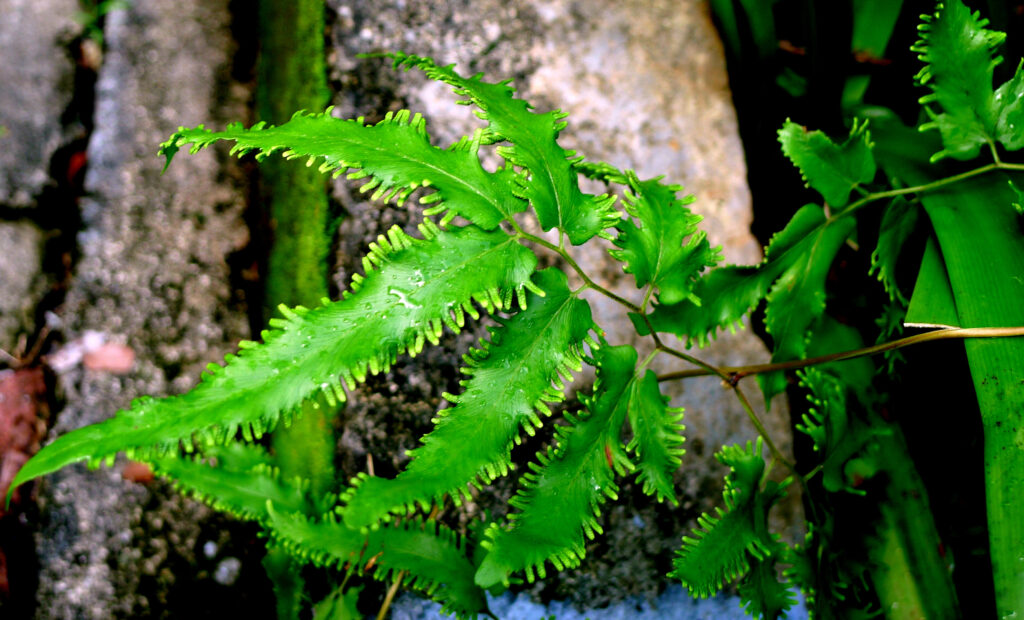
The Japanese climbing fern reproduces by spreading thousands of spores.
©Thecloudysunny/Shutterstock.com
11. Japanese Climbing Fern (Lygodium japonicum)
- Plant Description: The Japanese climbing fern has fern-like hairy leaflets (dissected or lobed), plus twining fronds and dark, wiry stems. This creeping invasive plant also produces many spores containing the chromosomes that create new plants.
- Mature Height: Japanese climbing ferns can grow 90 or more feet long or high
- Habitat: Can thrive in moist or dry soil, including woodlands, forests, woodlands, and roadsides
Like the Old World climbing fern, the Japanese climbing fern also stretches up to cover the nearest shrubs or trees and dominate them. Plus, it covers and chokes out all the other vegetation in its way.
Japanese climbing fern is one of Florida’s most invasive plants because it covers and kills native plants. Unfortunately, it also reproduces by spreading thousands of spores. Even plant-removing heavy equipment like bulldozers can become carriers of these vine spores, resulting in more plant spread.
The Japanese climbing fern is native to Asia and probably first appeared in Florida landscapes in the 1930s.
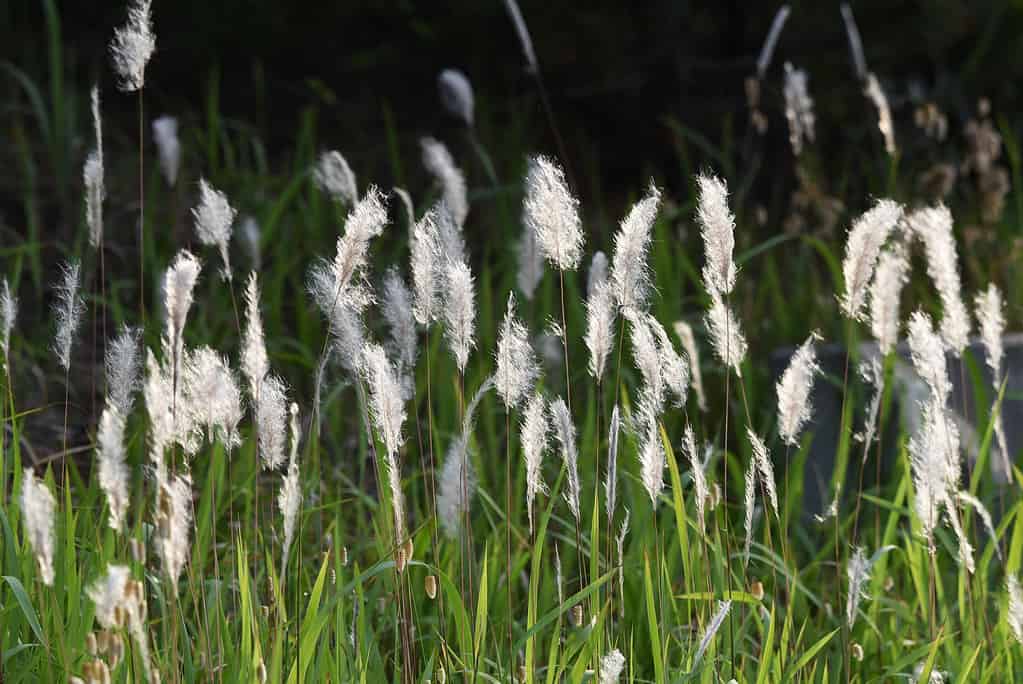
Pine plantations are often at risk of cogon grass infestations in Florida.
©tamu1500/Shutterstock.com
12. Cogon Grass (Imperita cylindrica)
- Plant Description: Cogon grass is a perennial plant with tall yellow-green leaf blades. This type of grass also produces sharp pointy rhizomes and fuzzy white seeds.
- Mature Height: Congon grass grows 5-7 feet high
- Habitat: Disturbed areas, waste sites, harvested timberlands, pine sites, and roadsides
Cogon grass is an invasive Florida plant that thrives in disturbed soil. Unfortunately, this invasive grass also loves spreading across pine plantations and destroys these crops by forming dense monocultures. When an invasive plant creates a monoculture, it kills off all the vegetation it grows around.
Drought-tolerant and adaptable to poor soil conditions, cogon grass is a formidable foe to invasive plant management teams. Unfortunately, it’s also a burden for firefighters because these blades of grass produce flammable oils. So cogon grass is one of the invasive grasses that increase fire occurrences across Florida and other states.
How did cogon grass become a non-native Florida plant? It first became a good grass for soil stabilization in the 1930s and 40s, imported from Asia and East Africa.
How to Control Invasive Plants in Florida
Control methods for the most invasive plants in Florida can vary based on the plant growth habit, the habitat, and other factors. The following links are helpful for control method guidance and reporting invasive plant sightings across the state:
- University of Florida Center for Aquatic and Invasive Species
- University of Florida IFAS Extension
- Florida Fish and Wildlife Conservation Commission
- National Invasive Species Information Center
Controlling invasive Florida plants involves stopping their spread plus reducing the introduction of new invasive species. So before you grow an unfamiliar plant, find out if it’s on an invasive species list. One easy way to do this research is through the Center for Invasive Species and Ecosystem Health.
The most invasive plants in Florida are costly and hard to control.
Invasive plant management in Florida costs the state millions of dollars in labor, herbicides, lost crops, wildlife displacement, replenishing native species, plant identification, public education, and more. And the plants from our list make those jobs much harder and more costly year after year. So it’s important to report sightings of the most invasive plants and other invasive species in Florida whenever possible. And it’s essential to avoid accidentally planting invasive plants on your own property.
Summary of the Top 12 Most Invasive Plants in Florida
| Number | Invasive Plant |
|---|---|
| 1 | Brazilian Pepper Tree |
| 2 | Old World Climbing Fern |
| 3 | Australian Pine |
| 4 | Tropical Soda Apple |
| 5 | Melaleuca |
| 6 | Air Potato |
| 7 | Camphor Tree |
| 8 | Kudzou |
| 9 | Skunkvine |
| 10 | Torpedograss |
| 11 | Japanese Climbing Fern |
| 12 | Cogon Grass |
The photo featured at the top of this post is © Scott Ehardt / public domain – License / Original
Thank you for reading! Have some feedback for us? Contact the AZ Animals editorial team.






